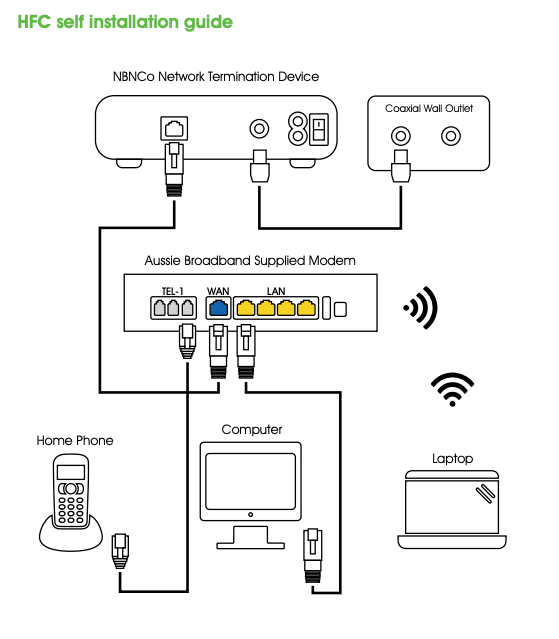How much faster is NBN 250?

Are the new NBN Home Superfast plans actually "Superfast"? We put them to the test.
NBN Co's release of new pricing structures for 1,000/50 ("NBN Home Ultrafast") and 250/25 ("NBN Home Superfast") has enabled NBN providers to offer faster speeds on fixed lines at more affordable pricing levels than ever before.
Aussie Broadband was the first provider to start offering these new plans to customers within the Fibre To The Premises (FTTP) and Hybrid Fibre Coaxial (HFC – the old Telstra/Optus cable networks) footprint.
I've been writing about the NBN since its inception, and when (at least initially) the vast majority of the country was slated for Fibre To The Premises connections, I was keen to push the speed barrier for Internet connectivity. So naturally, I wanted to jump onto that NBN Home Ultrafast speed tier as soon as possible. There was just one problem: I couldn't actually do so.
If you're in the FTTP footprint of the NBN you really did win the speed lottery, because gigabit NBN speeds (1,000Mbps +) are available to any premises served by FTTP as long as you're willing to pay for it.
The NBN connection in my area uses HFC, and NBN Co estimates that only around 7% of the HFC footprint is capable of serving gigabit speeds.
My own premises isn't in that 7% area, so I was sad.
However, it is in the 70% of the HFC footprint that can get NBN 250 services. NBN Co apparently wants 100% of the HFC network ready to offer NBN 250 by June 2021, but there's no public announcement around when that work will commence or if it'll see a wider expansion of gigabit NBN. It seems that NBN Co is waiting to see how well that 7% holds up before making it more widely available.
I signed up to an Aussie Broadband Home Superfast plan as soon as I was able to make the switch. Here are my observations on its value and pitfalls, but before I start I should note that Aussie Broadband also sponsors the Vertical Hold podcast I produce weekly. That has no effect on this article, but one of Finder's core values is being straight up and honest with our audience. This isn't a sponsored article and I pay my broadband bill at the end of the month, the same as you do.
How fast is NBN 250?
The quick answer is quite simple: very.
Though you probably want more detail than that. Plans at this speed tier should be capable of download speeds of up to 250Mbps, and upload speeds of up to 25Mbps. That models well with the way most consumers use Internet services, because we all tend to watch more Netflix than engage in video conferencing meetings under normal circumstances.
Using Finder's Internet Speed Test to gauge my overall speeds, I was highly impressed with the eventual results.
Actual speeds – especially over HFC, which is a shared spectrum – can vary by time of day, with evening peak hours usually being the heaviest hit. That's why providers usually reference their typical evening speeds in advertising, because it's sort of like a worst case scenario for what you can expect.
Over a number of evenings, I tested out the speeds I could get on my connection during the busy evening period. Here's what I got as an average for downloads, uploads and ping rate, compared to the theoretical maximums I could have hit.
NBN Home Superfast HFC
Speed Tests
That's with a wired gigabit ethernet connection. If you're using Wi-Fi, expect some packet loss and as a result a dip in speeds, especially as you get further from your Wi-Fi router.
There are some interesting data happening here, because I consistently hit more than my theoretical download speed at peak rates. That's almost certainly to do with Aussie Broadband slightly overprovisioning for customers on the NBN Home Superfast tiers.
In practical terms that additional percentage point or so of downloads isn't something you'll perceive in how you actually use the Internet. It will also be interesting to see how well that stands up after August, when NBN Co's current largesse in terms of CVC bandwidth comes to an end.
Then there's the issue of the uploads, which aren't anywhere near the stated maximums.
I very much expected that, however. I switched from a 100/40 connection, sacrificing those valuable uploads because I was already hitting genuine problems getting the full quota I was paying for on the HFC NBN.
I've had NBN technicians visit to check why this is so, and they've punted it back towards Aussie Broadband, who punted it back again to NBN Co. It is highly variable, and my own circumstances are not your own and your own connection may manage better than my lengths of HFC actually can. Of course, if you don't do that much uploading it may well be moot.
What can I do with all that speed?
The reality for most consumers is that speeds above the current 100Mbps tier are primarily of use if you're pulling down a lot of data from sources that can deliver that data at higher speeds. If you live alone and only watch standard definition Netflix, then you're no way in need of NBN Home Superfast or NBN Home Ultrafast speeds. In fact, you could get by pretty handily on most 25/5Mbps NBN connections in that case.
In my case, I run my freelance journalism business from a home office and I live with my family of five, all of whom use the Internet a lot. It's particularly true in the evening period where it's entirely feasible that there will be several Netflix streams running in different parts of the house, potentially a few video calls and downloads of the latest multi-gigabyte game patches to boot.
The recent coronavirus pandemic didn't help matters much, because I could very much tell that not only were my own household inhabitants online a lot more with distance learning and entertainment matters, but so was the rest of my neighbourhood. Again, HFC speeds don't exist in a vacuum, and if your neighbours are also heavily leaning on the infrastructure, you can feel the effects of it.
So while I can't push too many apps that directly hit that 250Mbps peak, there's utility in my case to incorporate all the needs of my household at all times. The price difference between what I was paying for a 100/40 connection and my new 250/25 connection is fairly easily recouped in my case by having that faster access to work more rapidly in a remote way, but your circumstances could of course differ. You can check out the difference in Aussie Broadband's plan pricing for these two plans below.
Compare other products
We currently don't have that product, but here are others to consider:
How we picked theseHow the Finder Score helps you find a better broadband plans
We designed the Finder Score to simplify your search for the best NBN and Home Wireless plans. By analysing hundreds of options from over 40 providers, we evaluate pricing, speeds, data allowances and plan features. Each factor is weighted and combined to generate a score out of 10 — helping you quickly spot the most competitive plans on the market. Read the full breakdown.
There's also an element of future-proofing in those speeds. Back when the NBN was first mooted, streaming video was in its infancy (especially in Australia) but now it's rather an expected part of our lives. As we shift to higher definition content and new apps and approaches, there's also potential to use those speeds and that interconnectivity in new ways. Although hopefully by then NBN Co will have sorted out my slightly dodgy upload speeds.
Will I need any new hardware for faster NBN?
The actual process for applying for a new account involved nothing more than selecting a few options on the Aussie Broadband website, and waiting for the rollover date on my particular plan. You shouldn't need a new visit by an NBN technician to install any new cables, because the actual provisioning of the speed happens purely between NBN Co and your provider.
However, you will need to check with Aussie Broadband (or any other provider offering NBN 250 plans) that your premises have been qualified as ready before you switch.
While you don't need new cables coming to your property or a new NBN connection point on the wall, you may need some newer technology to make the most of NBN Home Superfast (or NBN Home Ultrafast) if you've been connected for some time. You need to be able to actually pull down that level of data and feed it to your devices at an appropriate rate. That could include a new modem-router, depending on what you're using. Some older and cheaper routers, or some you may have purchased yourself may not be able to "talk" to the network at the requisite speeds or share them around your network as efficiently as possible.
Here's what your typical HFC set-up will look like:

Image: Aussie Broadband
My own set-up involves the default Netcomm modem-router supplied by Aussie Broadband. Where feasible it's generally a good idea to keep ISP gear in the loop, because it makes any support call that much easier to handle. That modem-router only acts as a bridge to a Linksys Velop Mesh system that does the heavy lifting for Wi-Fi and gigabit ethernet through to my home office located in another part of my house, and all of that should have been fine for everything up to NBN Home Ultrafast speeds.
I did hit one item I had to upgrade, and that was the USB Ethernet adaptor for my MacBook Pro. It's served me well over the years, and I hadn't given it much thought, but having purchased it back when the original MacBook Air came out (yes, I've been a tech journalist a long, long time, thanks for asking), it simply wasn't gigabit-capable. It could still connect, but I was maxing out at speeds that I could get on my prior HFC 100/40 connection.
Wired connections are always going to get more consistent throughput than wireless, and my home office area is particularly bad for wireless signals, so a direct connection was a must. Thankfully, all it takes is a quick trip to buy a gigabit capable USB-C adaptor, and you'll be in business.
How much does NBN 250 cost?
Aussie Broadband isn't the only provider offering 250/25 plans – Superloop and ANT Communications also have these plans, all of which you can compare below.
It's worth remembering that NBN Co estimates that only 70% of the HFC footprint is currently configured for NBN Home Superfast speeds, so it's possible to be on the HFC parts of the NBN and not be able to actually get a plan at those speeds at this time. Make sure you check with the provider that you're able to get these speeds before signing up to a plan.
Compare other products
We currently don't have that product, but here are others to consider:
How we picked theseHow the Finder Score helps you find a better broadband plans
We designed the Finder Score to simplify your search for the best NBN and Home Wireless plans. By analysing hundreds of options from over 40 providers, we evaluate pricing, speeds, data allowances and plan features. Each factor is weighted and combined to generate a score out of 10 — helping you quickly spot the most competitive plans on the market. Read the full breakdown.
You can find out more on NBN 250 speeds in our guide here.
Ask a question

